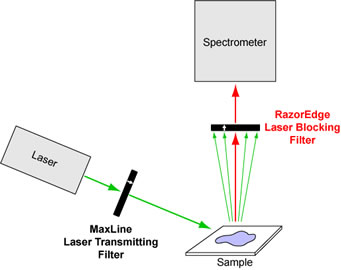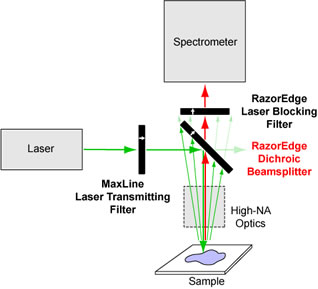RazorEdge Filter Layout for Raman Spectroscopy
by
IDEX Health & Science

In many Raman spectroscopy layouts, the only filters needed are a laser-transmitting filter to clean-up the laser spectral output and a laser-blocking filter to ensure that no Rayleigh-scattered laser light reaches the detection system (see Filter Types for Raman Spectroscopy Applications). In many high-performance Raman systems with microscopic imaging capabilities or highly sensitive remote probes it is desirable for the excitation laser beam and the Raman-shifted signal light to share a common light path. The illustrations below describe the two layouts and the ideal filters for each system.
 |  |
| In the standard Raman spectroscopy layout, the laser excites the sample directly, and a laser-blocking filter (such as the ultrasteep RazorEdge® LWP filter) is positioned between the sample and the spectrometer to block the scattered laser light and pass the Raman-shifted signal light. | In focusing or imaging systems where the incident beam and collected signal light to share a common path, a RazorEdge 45° beamsplitter reflects the laser light through the optics to the sample while efficiently transmitting the returning Raman-shifted signal light. A laser-blocking filter at normal incidence is used ahead of the spectrometer to completely block the undesired laser light. |
Learn more about Raman Spectroscopy:
